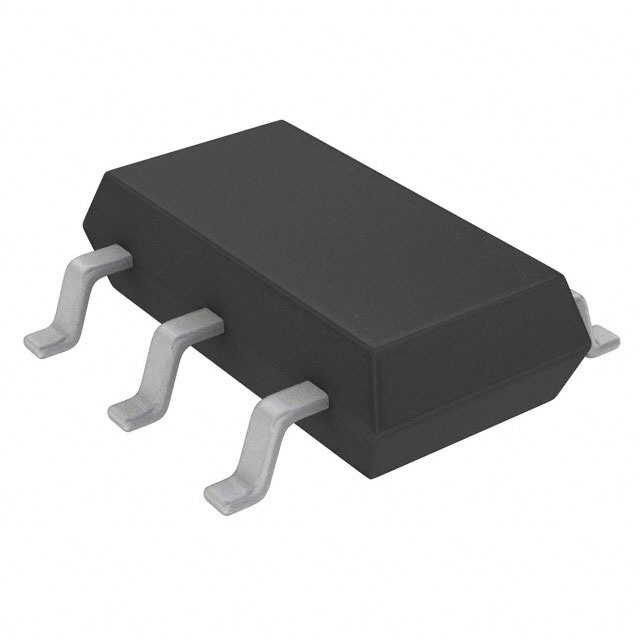LTC2050CS6#TRMPBF
Product Overview
Category
LTC2050CS6#TRMPBF belongs to the category of integrated operational amplifiers (op-amps).
Use
This product is commonly used in electronic circuits for amplification and signal conditioning purposes.
Characteristics
- Low offset voltage: The LTC2050CS6#TRMPBF has a very low offset voltage, ensuring accurate amplification of input signals.
- Low noise: It exhibits low noise characteristics, making it suitable for applications where signal fidelity is crucial.
- Rail-to-rail input and output: The op-amp supports rail-to-rail input and output voltage range, allowing for maximum utilization of the available supply voltage.
- Low power consumption: It operates at low power, making it suitable for battery-powered applications.
- Small package size: The LTC2050CS6#TRMPBF comes in a small SOT-23-6 package, enabling compact circuit designs.
Package and Quantity
The LTC2050CS6#TRMPBF is packaged in a SOT-23-6 package. It is typically sold in reels containing a specified quantity of units.
Specifications
- Supply Voltage Range: ±2.5V to ±15V
- Input Offset Voltage: 50µV (maximum)
- Input Bias Current: 1pA (maximum)
- Gain Bandwidth Product: 3MHz (typical)
- Slew Rate: 1.6V/µs (typical)
- Quiescent Current: 60µA (typical)
Pin Configuration
The LTC2050CS6#TRMPBF features a six-pin SOT-23 package with the following pin configuration:
```
| | --| IN- V+ |-- --| IN+ OUT |-- --| V- NC |-- |___________| ```
Functional Features
- Low offset voltage and low noise enable accurate amplification of small input signals.
- Rail-to-rail input and output capability allows for maximum signal swing.
- Low power consumption makes it suitable for battery-powered applications.
- High gain bandwidth product and slew rate ensure fast and precise signal processing.
Advantages and Disadvantages
Advantages
- Accurate amplification of small input signals
- Low noise for improved signal fidelity
- Rail-to-rail input and output range
- Low power consumption
- Compact package size
Disadvantages
- Limited supply voltage range compared to some other op-amps
- Relatively lower gain bandwidth product compared to high-speed op-amps
Working Principles
The LTC2050CS6#TRMPBF is an integrated operational amplifier that utilizes a combination of transistors and resistors to amplify and condition input signals. It operates based on the principles of differential amplification, where the difference between the two input voltages is amplified by a factor determined by the internal circuitry.
Detailed Application Field Plans
The LTC2050CS6#TRMPBF finds applications in various fields, including but not limited to: 1. Sensor signal conditioning 2. Audio amplification 3. Data acquisition systems 4. Portable instrumentation 5. Battery-powered devices
Alternative Models
For those seeking alternative options, the following models can be considered: - AD8628: Offers similar characteristics and performance with a different package. - MCP6002: Provides comparable specifications and features at a lower cost. - MAX4239: Suitable for high-precision applications with enhanced performance.
These alternative models offer similar functionality and can be used as substitutes depending on specific requirements.
In conclusion, the LTC2050CS6#TRMPBF is a versatile operational amplifier with low offset voltage, low noise, and rail-to-rail input/output capabilities. Its compact package and low power consumption make it suitable for various applications in sensor signal conditioning, audio amplification, data acquisition systems, portable instrumentation, and battery-powered devices. Alternative models such as AD8628, MCP6002, and MAX4239 can be considered based on specific needs.
기술 솔루션에 LTC2050CS6#TRMPBF 적용과 관련된 10가지 일반적인 질문과 답변을 나열하세요.
Sure! Here are 10 common questions and answers related to the application of LTC2050CS6#TRMPBF in technical solutions:
Q: What is LTC2050CS6#TRMPBF? A: LTC2050CS6#TRMPBF is a precision operational amplifier (op-amp) manufactured by Linear Technology (now part of Analog Devices). It is designed for low noise, low power, and high precision applications.
Q: What are the key features of LTC2050CS6#TRMPBF? A: Some key features of LTC2050CS6#TRMPBF include low input offset voltage, low input bias current, low noise, wide supply voltage range, and rail-to-rail inputs and outputs.
Q: What are the typical applications of LTC2050CS6#TRMPBF? A: LTC2050CS6#TRMPBF is commonly used in precision instrumentation, sensor signal conditioning, data acquisition systems, medical equipment, and other high-accuracy measurement applications.
Q: What is the input offset voltage of LTC2050CS6#TRMPBF? A: The input offset voltage of LTC2050CS6#TRMPBF is typically very low, usually in the microvolt range.
Q: What is the input bias current of LTC2050CS6#TRMPBF? A: The input bias current of LTC2050CS6#TRMPBF is typically very low, usually in the picoampere range.
Q: Can LTC2050CS6#TRMPBF operate from a single supply voltage? A: Yes, LTC2050CS6#TRMPBF can operate from a single supply voltage. It has rail-to-rail inputs and outputs, allowing it to work with signals close to the supply rails.
Q: What is the power supply voltage range for LTC2050CS6#TRMPBF? A: LTC2050CS6#TRMPBF can operate from a wide power supply voltage range, typically from 2.7V to 10V.
Q: Does LTC2050CS6#TRMPBF have built-in protection features? A: Yes, LTC2050CS6#TRMPBF has built-in protection features such as reverse battery protection and thermal shutdown.
Q: What is the output voltage swing of LTC2050CS6#TRMPBF? A: The output voltage swing of LTC2050CS6#TRMPBF is typically very close to the supply rails, allowing it to drive signals to the full extent of the power supply voltage.
Q: Is LTC2050CS6#TRMPBF available in a small form factor package? A: Yes, LTC2050CS6#TRMPBF is available in a small SOT-23-6 package, making it suitable for space-constrained applications.
Please note that the answers provided here are general and may vary depending on specific datasheet specifications and application requirements.


